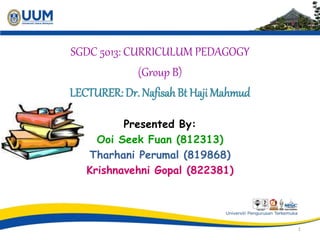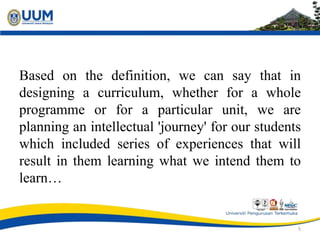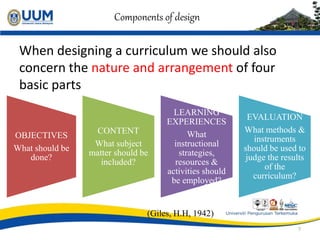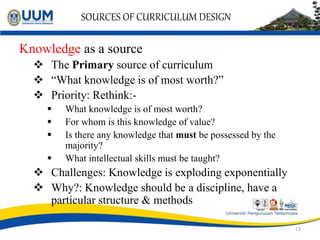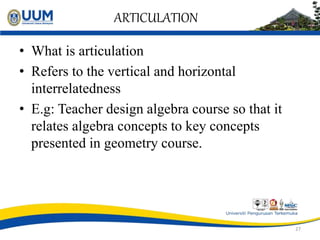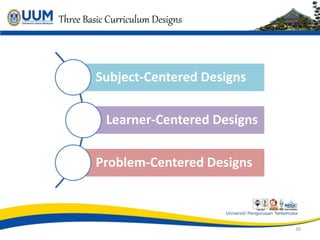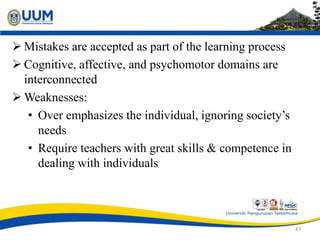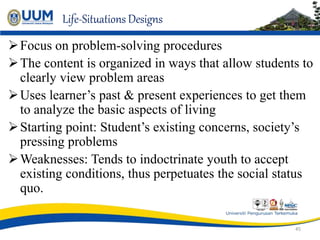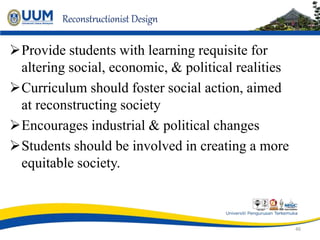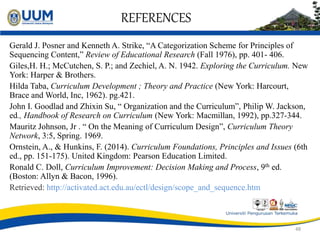Curriculum Design
- 1. SGDC 5013: CURRICULUM PEDAGOGY (Group B) LECTURER: Dr. Nafisah Bt Haji Mahmud Presented By: Ooi Seek Fuan (812313) Tharhani Perumal (819868) Krishnavehni Gopal (822381) 1
- 2. 3.0 Curriculum Design 3.1 Components of design and source 3.2 Design Dimension: Scope, Sequence, Continuity, Integration, Articulation & Balance 2
- 3. CURRICULUM DESIGN Definition: Curriculum design is a statement which identifies the elements of a curriculum, states what their relationships are to each other, and indicates the principles of organization and requirement of that organization for the administrative conditions under which it is to operate. (Hilda Taba, 1962) 3
- 4. CURRICULUM DESIGN Definition: Johnson identified three notions of curriculum design as; an arrangement of selected and ordered learning outcomes intended to be achieved through instruction an arrangement of selected and ordered learning experiences to be provided in an instructional situation a scheme for planning and providing learning experiences. (Johnson. Jr, 1969) 4
- 5. Based on the definition, we can say that in designing a curriculum, whether for a whole programme or for a particular unit, we are planning an intellectual 'journey' for our students which included series of experiences that will result in them learning what we intend them to learn… 5
- 6. 3.1 Components of design In designing curriculum, we should consider the philosophical and learning theories to determine if our design decisions are in consonance with our basic beliefs concerning: People What & How they should learn How they should use their acquired knowledge 6
- 7. Components of design When designing a curriculum we should also concern the nature and arrangement of four basic parts (Giles, H.H, 1942) 7 OBJECTIVES What should be done? CONTENT What subject matter should be included? LEARNING EXPERIENCES What instructional strategies, resources & activities should be employed? EVALUATION What methods & instruments should be used to judge the results of the curriculum?
- 8. Components of design Curriculum Design involves issues based on three base ideas; 8 Interpretation & Selection of objectives Selection & organization of content Decisions about how to teach the contents Evaluation of the developed curriculum Theoretical Philosophical Practical INFLUENCE
- 9. SOURCES OF CURRICULUM DESIGN 9 SOURCESCIENCE SOCIETY MORAL DOCTRINE KNOWLEDGE LEARNER
- 10. SOURCES OF CURRICULUM DESIGN Science as a source Contains only observable & quantifiable elements. Priority: Problem solving & thinking strategies Emphasizes learning how to learn Why? Because the knowledge increase so rapidly, the only constant seems to be the procedures by which we process knowledge. 10
- 11. SOURCES OF CURRICULUM DESIGN Society as a source Draw ideas from analysis of the social situation Operates within social, economic, & political contexts Priority: Address Students’ unique needs -> diverse social groups Emphasis: Collaboration among diverse individuals & groups Why?: School is an agent of society, -> we must consider current & future society. 11
- 12. SOURCES OF CURRICULUM DESIGN Moral Doctrine as a source Considering the relationship between knowledge & people’s spirituality. Guided by religious texts Priority: Questions about the nature of the world, the purpose of life, what it means to be human & knowledgeable Emphasis: Develop empathy & compassion, consider & promote welfare of others, welcome different viewpoints Why?: Allow for a blending of truth, faith, knowledge, ethics, thought, and action. 12
- 13. SOURCES OF CURRICULUM DESIGN Knowledge as a source The Primary source of curriculum “What knowledge is of most worth?” Priority: Rethink:- What knowledge is of most worth? For whom is this knowledge of value? Is there any knowledge that must be possessed by the majority? What intellectual skills must be taught? Challenges: Knowledge is exploding exponentially Why?: Knowledge should be a discipline, have a particular structure & methods 13
- 14. SOURCES OF CURRICULUM DESIGN Learner as a source Curriculum derived from our knowledge of students. How: They learn, form attitudes, generate interest, develop values Priority: Seeks to empower Students & foster their individual uniqueness. Emphasis: Draw ideas from psychological foundations, especially how minds create meaning Why?: Every learner is unique, educational environment physically affect brain development. 14
- 15. Guidelines for Curriculum Design Create a curriculum design committee Create a schedule meetings to make curriculum design decisions Gather data about educational issues and suggested solutions Process data on available curriculum designs, compare cost, scheduling, students characteristics and academic strengths, learning environments, whether community accept the design. Schedule time for reflection on the design Schedule time for revision of the design Explain the design to educational colleagues, community members, if appropriate, students. 15
- 17. HORIZONTAL ORGANIZATION HORIZONTAL- A horizontal curriculum means that what is studied in one particular course in an institution is in line with other, similar classes both in terms of course content and evaluation (across different subjects). EXAMPLE: A Chemistry class might require students to take Algebra II to balance the molecules; H2 + O2 g H2O If you do some of the mass calculations you will find this: 2 grams of hydrogen + 32 grams of oxygen = 18 grams of water Where did the 16 grams go? *We need to balance the equation through the law of conservation of mass using Algebra II (Quadratic Equation). Horizontal Curriculum Add Maths (Form 4-Chapter 2: Quadratic Equation) Chemistry (Form 4-Chapter 3: Chemical Formulae & Equation) 17
- 18. VERTICAL ORGANIZATION VERTICAL- A vertical curriculum links knowledge from one lesson to the next across a program of study. It establishes skills and knowledge which are used and further developed across a whole program of study. In this way, basic skills and knowledge are both developed and reinforced as other elements are introduced into study. This method is structured and progressive, focusing on building to advanced levels of knowledge. EXAMPLE: Form 4 students need to learn Function (Chapter 1) in Additional Mathematics so that they can have the basic skills and knowledge to find solutions in Integration (Chapter 3) in Form 5. Form 4- Function (Basic) Vertical curriculum Form 5- Integration (Advanced level) 18
- 19. DESIGN DIMENSIONS DESIGN DIMENSIONS Scope Continuity Integration Articulation Sequence Balance 19
- 20. Scope What is scope? It is the breadth and depth of the content. According to Ralph Tyler, scope is consisting of all the content, topics, learning experiences and organizing threads comprising the educational plan. John Goodlad and ZhiXin Su refers to the curriculum’s horizontal organization. 20
- 21. Scope All types of educational experiences to engage students in learning - Cognitive, affective, psychomotor learning( some might add the moral or spiritual domain) Simple listing of key topics and activities. Scope can extend over a year or more. Units > lesson plans > information and activities into periods of hours or minutes For example : Mathematics of Year 1. 21
- 22. Sequence Definition: The order or arrangement in which the content should be taught for the best learning (building on past knowledge) throughout the course. Educators must decide the sequence before a course begins to be effective. (Source:http://activated.act.edu.au/ectl/design/scope_and_sequence.htm) Vertical relationship among the elements to provide continuous and cumulative learning. Contents and experiences are arrange in hierarchical manner where the basis can either be logic of the subject matter or on the developmental patterns of growth of the cognitive, affective and psychomotor domains. 22
- 23. 4 Principles for Sequence • Simple to Complex Learning – content & experiences are organized from simple to complex, concrete to abstract, easy to difficult. • Prerequisite Learning- there are fundamental things to be learned ahead. • Whole to Part Learning – overview before the specific content or topics. Related to gestalt principle. • Chronological learning – the order of events is made as a basis of sequencing the content and experiences. (Smith, Stanley and Shore, 1957) 23
- 24. 4 MAJOR PRINCIPLES FOR sequencing CONTENTS IN UNITS Concept- related sequence- how ideas are related together in logical manner. Inquiry- related sequence- based on the process of generating, discovering & verifying knowledge, content and experiences are sequenced logically and methodically. Learning- related sequence- pupils learn through experiencing contents and activities. Utilization- related sequence- how people use their knowledge through an activity. (Posner & Strike, 1976) 24
- 25. Continuity Is vertical repetition of curriculum components. Reading skills or crucial concepts and skills must be experienced repeatedly to be further developed. For example: the addition of primary school, play violin. Herbert Simon- we all can be masters of something if we devote sufficient time and effort. ( constructivist approach) 25
- 26. INTEGRATION Definition: Refers to linking all types of knowledge and experiences contained within the curriculum plan (Ornstein & Hunkins, 2014). Emphasizes on horizontal relationships “Everything is integrated and interconnected. Life is a series of emerging themes. ” This is the essence of integration in the curriculum design. Organization is drawn from the world themes from real life concerns. Subject matter content or disciplined content lines are erased and isolation is eliminated. People cannot disconnect themselves from their inquiries, and the curriculum cannot exist as separate bits. 26
- 27. ARTICULATION • What is articulation • Refers to the vertical and horizontal interrelatedness • E.g: Teacher design algebra course so that it relates algebra concepts to key concepts presented in geometry course. 27
- 28. ARTICULATION 28
- 29. BALANCE • When designing curriculum educators strive to give appropriate weight to each aspect of design • Balanced curriculum = students acquire and use knowledge in ways to advance their personal ,social, intellectual goals. • But Doll ( Curriculum Improvement) stated achieving balance is difficult. • WHY: striving to localize and individualize the curriculum while need to maintain a common content • Solution: requires fine tuning in philosophy and psychology of learning. 29
- 30. 30 Three Basic Curriculum Designs Subject-Centered Designs Learner-Centered Designs Problem-Centered Designs
- 31. Subject-Centered Designs I. Subject Designs II. Discipline Designs III.Broad-Field Designs IV.Correlation Designs V. Process Designs 31
- 32. Subject Designs Oldest and Best known Related to “Textbook treatment” & “Teachers as SME” Exists whenever there are stress on standards & accountability to schools Strengths:- Introduces students to essential knowledge of society Easy to deliver, textbook & materials commercially available 32
- 33. Weaknesses Disempowers students to choose the content which is most meaningful to them Presented without consideration of context Fails to foster social, psychological, & physical development Neglects students needs, interest and experiences Foster students passivity 33
- 34. Discipline Designs Focus on the academic disciplines Students would approach history as a historian would Investigate biological topics by following procedures used by biologists. Stress on understanding the conceptual structures & processes of the disciplines Strength: Students master the content areas & able to independently continue their learning Weaknesses: A lot of knowledge cannot be classified as “disciplined”. Eg: aesthetics, humanism, personal-social living 34
- 35. Broad-Fields Design Aka interdisciplinary design Focus: Give student a sweeping understanding of ALL content areas, integrate contents that fit together logically Eg:-”geography,economics,political science, anthropology, sociology, history”->”social Studies” Strength: Simple, Students learn wide area of knowledge. Weaknesses: The depth of knowledge is insufficient. 35
- 36. Correlation Design In the middle of “Separate Subjects” & “Total Content Integration” Attempts to identify ways to relate subjects, but maintain their separate identities. Students in a chemistry course may have a unit in math that deals with mathematics required to conduct an experiment Eg: (Science & Math) (Literature & History) Strength: Innovative & Attractive Weaknesses: Time Consuming, Teachers often separate departments, Scheduling difficulties 36
- 37. Process Designs Urge students to learn the “process of obtaining knowledge” Eg: Biological procedures to learn biology, ethnographic procedures to study culture & society Strength: SS as a meaning maker, enables to analyze reality, create frameworks by which to arrange derived knowledge. Weaknesses: Difficult to analyze validity of students’ conclusion individually. 37
- 38. Learner-Centered Designs I. Child-Centered Design II. Experience-Centered Design III.Romantic (Radical) Design IV.Humanistic Design 38
- 39. Child-Centered Design Students must be active in their learning environments. Child centered ,experience centered curriculum Design based on students lives, needs, interest Belief: effective learning did not require strict discipline, child’s innate tendency to become engaged with interesting knowledge Organized around human impulses: to socialize, to construct, inquire, experiment, express/create. 39
- 40. Experience-Centered Design A curriculum that is not pre-planned, done “on the spot” Why?: child’s needs and interests cannot be anticipated. ( Have faith in each students uniqueness) Students design their own learning, construct & revise their knowledge through direct participation & active observation Teachers design potential experiences for students to consider Search for starting points, interest->linked to formalized knowledge 40
- 41. Romantic (Radical) Design Students must learn ways of engaging in a critique of knowledge Learning is reflective, it is not externally imposed by someone in power Radicals view society as deeply flawed & believe that schools used curriculum to control & indoctrinate, not to educate & emancipate Students must accept responsibility for educating themselves & demand freedom 41
- 42. Humanistic Design Emphasis on the disciplines Allow individuals to become full functioning persons Emphasized human potential, empowering students by actively involving the in their own growth Teachers must permit students to feel, value, grow Teacher provide environments that encourages genuineness, empathy, & respect Students approach problems with flexibility & intelligence, work cooperatively but do not need other’s approval Education should address pleasure and desire.. Curriculum should elicit emotion 42
- 43. Mistakes are accepted as part of the learning process Cognitive, affective, and psychomotor domains are interconnected Weaknesses: • Over emphasizes the individual, ignoring society’s needs • Require teachers with great skills & competence in dealing with individuals 43
- 44. Problem-Centered Designs • Focuses on real-life problems of individuals & society I. Life-Situations Designs II. Reconstructionist Design 44
- 45. Life-Situations Designs Focus on problem-solving procedures The content is organized in ways that allow students to clearly view problem areas Uses learner’s past & present experiences to get them to analyze the basic aspects of living Starting point: Student’s existing concerns, society’s pressing problems Weaknesses: Tends to indoctrinate youth to accept existing conditions, thus perpetuates the social status quo. 45
- 46. Reconstructionist Design Provide students with learning requisite for altering social, economic, & political realities Curriculum should foster social action, aimed at reconstructing society Encourages industrial & political changes Students should be involved in creating a more equitable society. 46
- 47. 47
- 48. REFERENCES Gerald J. Posner and Kenneth A. Strike, “A Categorization Scheme for Principles of Sequencing Content,” Review of Educational Research (Fall 1976), pp. 401- 406. Giles,H. H.; McCutchen, S. P.; and Zechiel, A. N. 1942. Exploring the Curriculum. New York: Harper & Brothers. Hilda Taba, Curriculum Development ; Theory and Practice (New York: Harcourt, Brace and World, Inc, 1962). pg.421. John I. Goodlad and Zhixin Su, “ Organization and the Curriculum”, Philip W. Jackson, ed., Handbook of Research on Curriculum (New York: Macmillan, 1992), pp.327-344. Mauritz Johnson, Jr . “ On the Meaning of Curriculum Design”, Curriculum Theory Network, 3:5, Spring. 1969. Ornstein, A., & Hunkins, F. (2014). Curriculum Foundations, Principles and Issues (6th ed., pp. 151-175). United Kingdom: Pearson Education Limited. Ronald C. Doll, Curriculum Improvement: Decision Making and Process, 9th ed. (Boston: Allyn & Bacon, 1996). Retrieved: http://activated.act.edu.au/ectl/design/scope_and_sequence.htm 48
